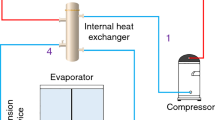Abstract
The aim of the present work is to bring out an exergy analysis of the hydrocarbon refrigerant mixture of R290/R600a as an alternative to R134a on the performance of a domestic refrigerator which is originally designed to work with R134a. The performance of both refrigerants was evaluated using an exergy analysis. The effects of evaporator temperature on the coefficient of performance (COP), exergy loss, exergic efficiency, and efficiency defect in the four major components of the system for R134a and R290/R600a mixture were experimentally investigated. The results obtained showed that the COP of R290/R600a mixture was improved up to 28.5 % than that of R134a. The highest average exergic efficiency of the system (42.1 %) was obtained using R290/R600a mixture at an evaporator temperature of 263 K (−10 °C). The overall efficiency defect in the refrigeration cycle working with R290/R600a mixture was consistently better than R134a.







Similar content being viewed by others

Abbreviations
- COP:
-
Coefficient of performance
- GWP:
-
Global warming potential
- h :
-
Specific enthalpy (J kg−1)
- T 0 :
-
Ambient temperature (K)
- s :
-
Specific entropy (J kg−1 K−1)
- \( \dot{m} \) :
-
Mass (refrigerant) flow rate (kg s−1)
- \( W_{\text{c}} \) :
-
Compressor work input (W)
- \( Q_{\text{cond}} \) :
-
Heat removed at condenser (W)
- \( Q_{\text{eva}} \) :
-
Refrigerating effect (W)
- \( T_{\text{cond}} \) :
-
Condenser temperature (K)
- \( T_{\text{eva}} \) :
-
Evaporator temperature (K)
- ψ:
-
Exergy flow (J kg−1)
- η x :
-
Exergy efficiency (%)
- δ:
-
Efficiency defect
- comp:
-
Compressor
- cond:
-
Condenser
- exp:
-
Expansion device
- eva:
-
Evaporator
References
Radermacher R, Kim K. Domestic refrigerators: recent developments. Int J Refrig. 1996;19:61–9.
Ashford P, Clodic D, McCulloch A, Kuijpers L. Emission from the foam and refrigeration sectors comparison with atmospheric concentrations, Part 2: results and discussion. Int J Refrig. 2004;27:701–16.
McCulloch A, Lindley AA. From mine to refrigeration: a life cycle inventory analysis of the production of HFC134a. Int J Refrig. 2003;26:865–72.
McCulloch A, Midgley PM, Ashford P. Release of refrigerant gases (CFC12, HCFC22, HFC 134a) to the atmosphere. Atmospheric Environ. 2003;37:889–902.
Li G, Hwang Y, Radermacher R. Review of cold storage materials for air conditioning application. Int J Refrig. 2012;35:2053–77.
Li G, Hwang Y, Radermacher R, Chun H-H. Review of cold storage materials for subzero applications. Energy. 2012. doi:10.1016/j.energy.2012.12.0025 Available online 8 Jan 2013.
Li G, Liu D, Xie Y. Study on thermal properties of TBAB-THF hydrate mixture for cold storage by DSC. J Therm Anal Calorim. 2010;102(2):819–26.
Fatouh M, ElKafafy M. Assessment of propane/commercial butane mixtures as possible alternatives to R134a in domestic refrigerators. Energy Convers Manag. 2006;47:2644–58.
Jung DS, Kim C-B, Song K, Park BJ. Testing of propane/isobutene mixture in domestic refrigerators. Int J Refrig. 2000;23:517–27.
Akash BA, Said SA. Assessment of LPG as a possible alternative toR-12 in domestic refrigerator. Energy Convers Manag. 2003;44:381–8.
Lee YS, Su CC. Experimental studies of isobutane (R600a) as the refrigerant indomestic refrigeration system. Appl Therm Eng. 2002;22:507–19.
Wongwises S, Chimres N. Experimental study of hydrocarbon mixtures to replace HFC134a in domestic refrigerators. Energy Convers Manag. 2005;46:85–100.
Fatouh M, ElKafafy M. Experimental evaluation of a domestic refrigerator working with LPG. Appl Therm Eng. 2006;26:1593–603.
Mani K, Selladurai V. Experimental analysis of new refrigerant mixture asdrop-in replacement for CFC12 and HFC134a. Int J Therm Sci. 2008;47:1490–5.
Mohanraj M, Jeyaraj S, Muraleedaran C. Experimental investigation of R290/R600a as an alternative to R134a in a domestic refrigerator. Int J Therm Sci. 2009;48:1036–42.
Anand S, Tyagi SK. Exergy analysis and experimental study of a vapor compression refrigeration cycle: a technical note. J Therm Anal Calorim. 2012;110:961–71.
Anand S, Gupta A, Tyagi SK. Simulation studies of refrigeration cycles: a review. Renew Sustain Energy Rev. 2013;17:260–77.
Tyagi SK, Park SR, Tyagi VV, Anand S. Second law based performance evaluation and parametric study of a sea water source cascade heat pump. Int J Exergy. 2010;7(3):369–86.
Said SAM, Ismail B. Exergetic assessment of the coolants HCFC 123, HFC 134a, CFC 11and CFC 12. Energy. 1994;2011(19):1181–6.
Aprea C, Greco A. An exergetic analysis of R22 substitution. Appl Therm Eng. 2002;22:1455–69.
Aprea C, Renno C. Experimental comparison of R22 with R417A performance in a vapor compression refrigeration plant subjected to a cold store. Energy Convers Manag. 2004;45:1807–19.
Padilla M, Remi R, Jocelyn B. Exergy analysis of R413A as replacement of R12 in a domestic refrigeration system. Energy Convers Manag. 2010;51:2195–201.
Kumar S, Prevost M, Bugarel R. Exergy analysis of a compression refrigeration system. Heat Recovery Syst CHP. 1989;9:151–7.
Arora A, Kaushik SC. Theoretical analysis of vapour compression system with R502, R404A and R507A. Int J Refrig. 2008;31:998–1005.
Sekhar SJ, Lal DM. HFC134a/HC600a/HC290 mixture a retrofit for CFC12systems. Int J Refrig. 2005;28:735–43.
Author information
Authors and Affiliations
Corresponding author
Rights and permissions
About this article
Cite this article
Saravanakumar, R., Selladurai, V. Exergy analysis of a domestic refrigerator using eco-friendly R290/R600a refrigerant mixture as an alternative to R134a. J Therm Anal Calorim 115, 933–940 (2014). https://doi.org/10.1007/s10973-013-3264-3
Received:
Accepted:
Published:
Issue Date:
DOI: https://doi.org/10.1007/s10973-013-3264-3



